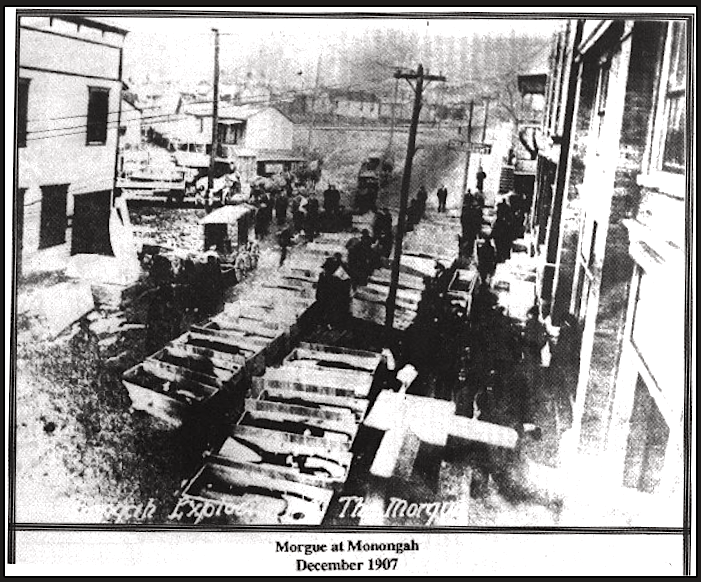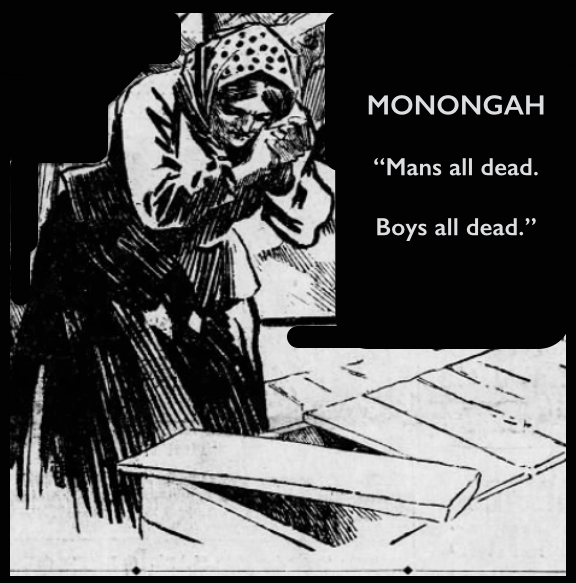
Hellraisers Journal, Monday December, 23, 1907
Monongah, West Virginia – Women Weep for Husbands and Sons
From the Kansas Pittsburg Daily Headlight of December 21, 1907:
A PICTURE OF DESPAIR.
—–
Thirty Five Boys Among the
Fairmont Mine Victims.
—–
(By Dorothy Dale.)Fairmont, W. Va., Dec. 21.-O God! It was the cry of supplication. It was the cry of horror. It was the cry of despair. It was the one, a comprehensive cry of mercy, which could be heard.
There is still some doubt about the exact number of lives snuffed out. But there is no doubt about the windows and orphans, to one who has seen Monongah the scene of the disaster.
“You’ll find it tough,” they said. I found it tough. Monongah at best is a little weather-beaten wooden village straggling in the mud of the West Virginia hills. It lies on two sides of the river, now known as the morgue side and the mine side. On the morgue side an endless chain of women and children pass all day past the coffins.
The Grewsome Work.
The work of bringing out the dead went steadily forward at No. 6 all day. By nightfall forty-one bodies were sent to the homes awaiting their coming. Though pine boxes piled in front of the mine seemed almost endless, they were insufficient to supply the need.
“O God, it’s Benny’s body!” cried a woman peering out from her doorstep as a wagon drew up. Her eyes were smoldering coals in their black sockets.
Black Wagon’s Visit.
Her clinched hands tore her apron to shreds, and as the driver jumped down and hurriedly rattled out a short, tapering brown box, she turned and rushed into the little living room, where a larger brown, tapering box lay. Other drawn-faced waiters tried to comfort her. She pushed them off.
“O God!” O-but there can’t be a God: there were 35 boys among that ill-fated 400.
One after another the dreaded, yet feverishly expected visit of the black wagon was made. The small squares of the coffin lids were raised. Faces and hands were burned to a crisp. The searched eyes stared their last look of horror.
The blackened features were distorted in agony. The ghastly teeth protruded. There were no embalmers to compose the bodies of these men before rigor mortis set in. They died like rats in a hole struggling, suffering ground black and charred, like the coal they were digging.
Here’s Rent Tragedy.
In a bare, unpainted, soot-grimed house No. 28, in a row of miners’ houses, all alike, Mary Hudec sat with her dead husband alone. Her face drawn by anguish, [pale and?] white. Her eyes were dry. Burning they stared out from hollow sockets upon the brown box in which the dead man lay.
The ends of it rested on two kitchen chairs. He lay as they had brought him home to her-lay almost as they had found him deep in the wrecked mine.
His face, the dead, toil-worn face she loved, was torn, and burned the blackened features distorted in agony. The hands were clenched as when he fought death in the pit-fought for life, for home and the young wife waiting for him.
Took Husband and Son.
The kitchen stove was cold. She had had no fire and no food since the explosion, three days before. The night of the second day they brought her husband’s body home. Now they were bringing home her boy.
Through the smoky air a thin rain drizzled down. Up the hill the undertaker’s wagon toiled. Slowly it neared the home, but the woman did not lift her head. Through blankly staring eyes she saw her boy as he had left her to go to work, one of the 35 lads who met death with their fathers in the mines. She was standing in the door way of their home.
A Mother’s Shriek.
The wagon stopped outside. Quickly the man rattled out the oblong pine box, brown-painted like the father’s but smaller. The woman, swaying on her feet, but still dry-eyed, was at the door to meet them. Her hand clutched the knob and her face turned a shade whiter as they passed, tramping inside.
Now they were gone. The dead lay side by side. A frenzy of new grief overtook the stricken woman [as she?] snatched from the boyish face, blackened, twisted, burned unspeakably, the cloth that covered it.
One cry, a mother’s shriek.
The Family Joined.
Down, senseless, beside the two brown oblong boxes, the woman’s body slid, turned over and lay still. The little family was joined.
Outside the rain fell on a soot-black, barren earth. Over it all an awful silence lay. Hardly a gate was without its gruesome sign of death. I brushed the crepes as I passed on down the narrow, broken street.
———-
MERE CHILDREN VICTIMS.
—–
Eleven Year Old Boys Killed
in Monongah Mine.
—–Monongah, West Va., Dec. 21.-The body of an eleven-year-old-boy has been taken from mine No. 6. He was “Devil” John Keney, a trapper boy in Left E face of the mine. Identification of the little body was made by Edward Buckley, a miner. Buckley said he had known the Keney family for years and had known the dead trapper boy since his birth. He was certain he said, of the age of the baby victim. There is a fourteen-year-old labor law in West Virginia.
A claim that the death list will not exceed 300 was made by President Watson of the Fairmont Coal Company, in a telegram to Governor Dawson. This claim is in no way born out by the conditions. The bodies which will actually be recovered may not exceed 300.
Two frightful causes will create this condition if it occurs. An unknown number of bodies, estimated at fifty were consumed in the fire in mine No. 8. An unknown number of men, which can in no way be estimated, were blown absolutely to fragments that bear only human resemblance.
Twenty thousand dollars has been donated to the Monongah relief fund. Seventeen thousand five hundred have been given by the officials of the Fairmont Company and $2,500 by ex-Senator Camden, owner of the Monongah coal properties that are under lease to the coal trust. All of this has been deposited at the First National Bank of Monongah to the order of J. E. Sands, and will be distributed to the proper persons at the earliest time consistent.
———-
[Photographs added.]
SOURCE
The Pittsburg Daily Headlight
(Pittsburg, Kansas)
-Dec 21, 1907
https://www.newspapers.com/image/94709217/
IMAGES
Monongah MnDs, Morgue, Dec 1907
http://www.wvgenweb.org/wvcoal/mono.html
Monongah MnDs, Woman Praying, Ptt Prs, Dec 10, 1907
https://www.newspapers.com/image/142132645
See also:
Tag: Monongah Mine Disaster of 1907
https://weneverforget.org/tag/monongah-mine-disaster-of-1907/
Pretty Bird – Hazel Dickens


